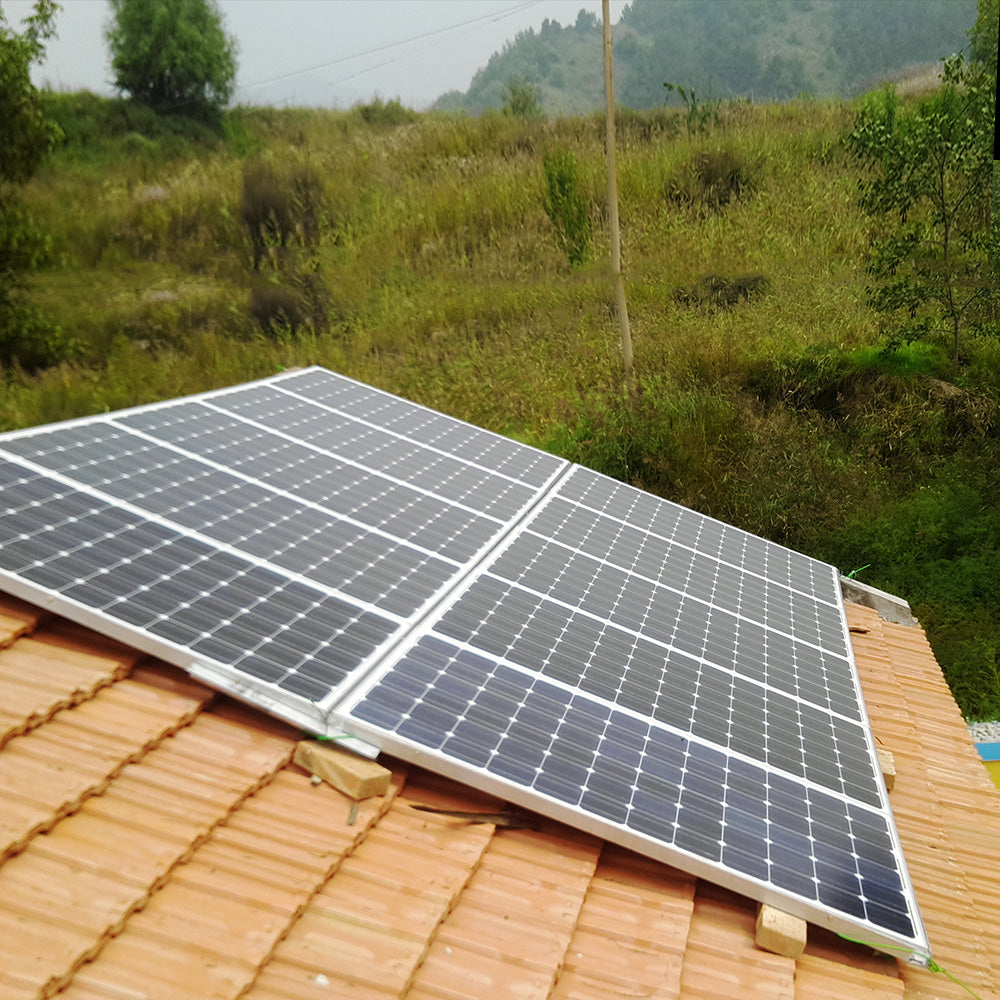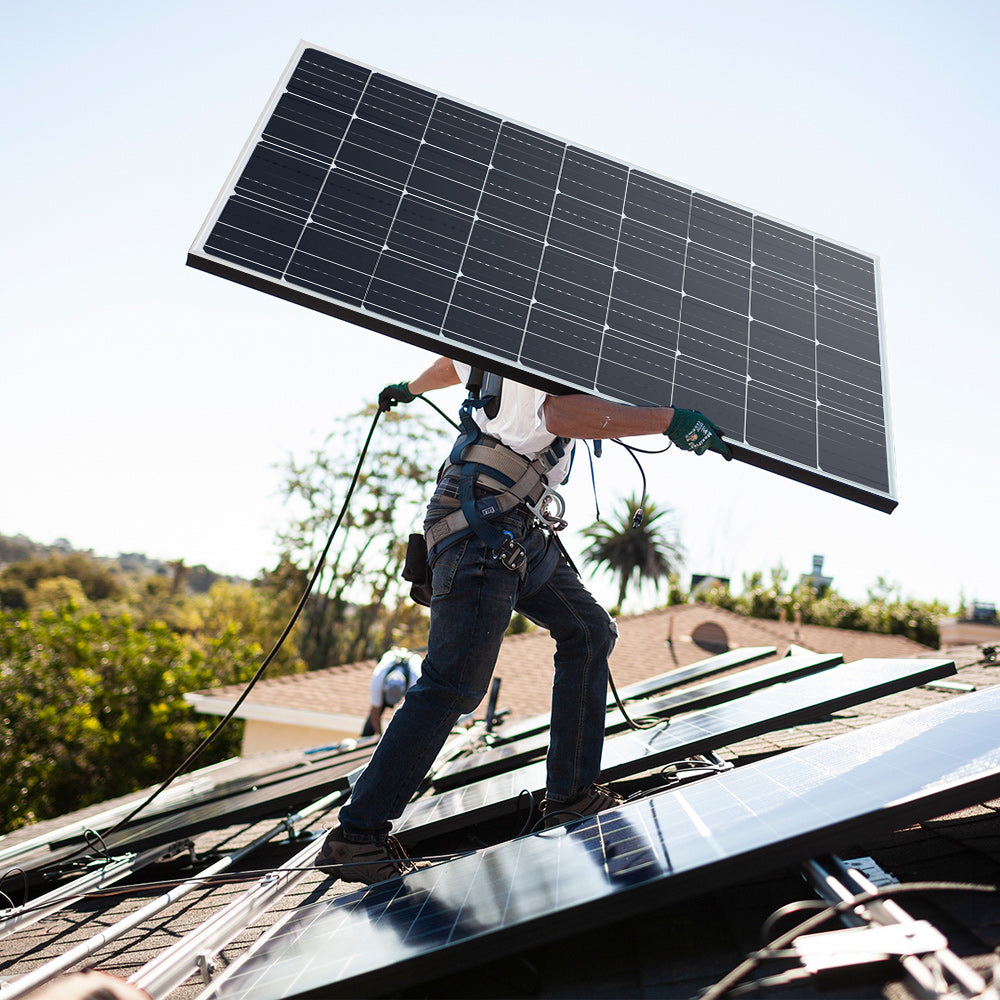The future of solar energy technology innovation will continue to develop, making it easier for ordinary people to obtain efficient panels. Given that the amount of sunlight reaching the earth per hour is enough to provide the whole earth with electricity for a year, the potential of solar energy is unlimited.
☀☀☀☀☀
The working principle of solar panels
The function of the solar panel system is simpler than people think.
The sun releases tiny energy packets called photons. These energy packets travel to the earth. This sunlight will irradiate the panel in different amounts depending on the direction of the panel and the location of your home. When a solar panel connects to a solar cell, the solar panel will convert solar energy (photons) into electricity by releasing electrons from the atoms. These electrons then flow to the inverter through the conduit.
Inverters convert electrical energy from direct current to alternating current. Alternating current is the electricity we use for lights, appliances, and equipment (anything that can plug into a wall outlet). Then the AC enters your electric meter to supply power to your home or city grid.
When the sun is not shining and your solar panel does not have any solar energy to convert into electricity, your home will continue to be powered by the grid. If your solar panel system generates more power than you use at any given moment, that power will flow from your home back to the grid. Many utility companies have net metering policies that attribute the excess solar energy you generate to you.
☀☀☀☀☀
What direction should the solar panels face?
Ideally, solar panels installed on a standard sloping roof should face south to achieve maximum output. If your solar panels face southeast or southwest, you can expect them to generate about 10% less electricity, but they may still be enough to power your home.
If you cannot install solar panels facing south, please consider:
Install solar panels facing different directions: West or southwest-facing solar panels may still be able to generate enough energy to fully or partially power your home. Your installation professional can make this decision.
Install more solar panels: Although solar panels that are not facing south will not receive too much direct sunlight, you can compensate by using more panels.
Install solar panels on the ground or the wall: You think you can only install solar panels on the roof, which is a common misunderstanding. If you don't like the appearance or the roof does not face south, you can install the solar system on a south-facing wall that can receive direct sunlight. A ground-mounted system is also possible. As long as you have the space in this area, you can choose this installation method because it is cheaper than installing and maintaining a wall-mounted system.
Installation professionals can also use technology to track how the sun hits your house so that they can install the panels facing the correct direction at the right slope.
☀☀☀☀☀
✈What is the best roof angle for solar panels?
The optimal roof angle for solar panels is about 30 degrees to maximize energy output. But it does not mean that solar panels are not suitable for steeper or flat roofs.
Consider that to get the best solar panel performance, you need to increase the latitude of your area by 15 degrees in winter. Then tilt your solar panel system to any number. In summer, subtract 15 degrees from the latitude of your area and adjust the angle of the solar panel system accordingly.
✈ Is the roof too steep for solar panels?
Most roofs are not particularly steep, but even if your roof is very steep, your solar panels may still work well enough to provide enough energy for your home. The best roof angle is about 30 degrees, but if your roof slope is 40 degrees, it will only reduce power generation by about 1%.
Any roof over 40 degrees is likely to be too steep, and if your goal is complete energy independence, then solar panels may not be a logical addition to your home.
✈ Solar panels on the flat roof
The installation process of solar panels on flat roofs is usually much simpler than for sloping ones. Because it is easier to move around and thus finish faster.
Solar installations on flat roofs do not require penetrating brackets required for sloping roofs to keep the panel system safe. Alternatively, a weighted installation system (also called a ballast system) is used for flat roofs without the need to drill holes in the roof. This type of system does not require holes but uses gravity to ensure that your solar panel system is stable and safe.
However, since flat roofs have no angle, use an upward-sloping bracket to keep your system at a 30-degree angle.
What is the best direction for rooftop solar panels?
The best direction for solar panels is south. However, if the roof of your home does not face that direction, you can face southeast or southwest.
Depending on the hemisphere you live in, this answer may be the opposite. For people living in the northern hemisphere, when we follow our orbit throughout the year, the sun travels along the southern part of the sky, so your solar panels need to face south. Similarly, people living in the southern hemisphere need to face the solar panels to the north (or northeast or northwest).
✈ How much roof space is needed for solar panels?
The roof space required for solar panels depends entirely on the type and manufacturer of solar panels, the size of the house, and the amount of electricity you usually use every day.
✈ Are solar panels harmful to your roof?
Solar panels will not damage your roof. But some factors need to be considered, especially during the installation process. Since drilling is required to secure the solar panel to the roof, it may inherently leave holes, which may cause water leakage over time.
The professional operation of installation professionals can avoid long-term damage to your roof and ultimately to your house caused by drilling. Therefore, it is very important to install solar panels correctly for the first time.
Although drilling holes in the roof sounds unattractive, many safety measures help ensure that this does not cause any damage.
Drilling holes are used for square head bolts to fix the mounting frame of the solar panel system. To avoid water leakage, the holes are filled with sealant, and then the square head bolts are surrounded by metal or plastic waterproof panels, which is a kind of protective cover under any type of roof tiles you have. Then seal the waterproof board with tar or other durable material to ensure that your roof is not damaged and potential leaks.
☀☀☀☀☀
When should you use solar energy?
It is a wise life decision to use solar energy at any time, but buying and installing solar panel systems before summer will get the most benefit. You can keep your home cool by up to 5°F by shading the roof, which is especially useful in warm summers-this reduces your home’s annual cooling load by 38%.
Transitioning to solar energy will not only save you on electricity bills, but it may also help you keep your lights on during high summer temperatures and more likely power outages. Since electricity bills may fluctuate for consumers during the summer, it is wise to use solar energy before the start of the hot season, but it needs to be clear that any time is a good time.
☀☀☀☀☀
There are many benefits to using solar energy. You can achieve energy independence while saving energy.
Don't let anything hinder you and install the system of your dreams. No matter where you live or which direction the roof faces, experienced and trustworthy solar panel installers can help you use solar energy.
We are happy to provide help. Please feel free to contact us.



